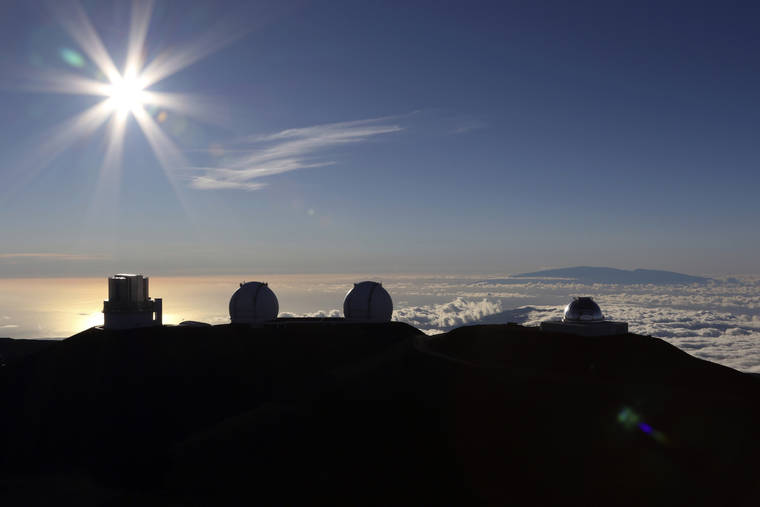Mauna Kea telescopes close in response to stay-at-home order

ASSOCIATED PRESS / 2019
The sun sets behind telescopes at the summit of Mauna Kea. The observatories have shut down their operations in response to Gov. David Ige’s stay-at-home order aimed at preventing the spread of COVID-19.
The observatories on Mauna Kea have shut down their operations in response to Gov. David Ige’s stay-at-home order aimed at preventing the spread of COVID-19. Opens in a new tab
This is the second time in less than a year the world-class science produced by the dozen or so observatories atop Hawaii’s tallest mountain have ground to a halt.
The first time was last summer at the beginning of the protest against the Thirty Meter Telescope, when Mauna Kea Access Road was blocked and deemed unsafe to travel for nearly four weeks.
“It’s deja vu,” said Doug Simons, director of Canada- France-Hawaii Telescope. “We know the drill.”
Like last summer, the latest shutdown will affect more than 500 technicians, astronomers, instrument scientists, engineers and support staff who work at both the summit and the observatory bases down below.
Most of the work is federally funded and therefore few, if any, employees will be laid off or furloughed for the time being, Simons said.
Don't miss out on what's happening!
Stay in touch with breaking news, as it happens, conveniently in your email inbox. It's FREE!
The largest impact will be on the science. Last year’s monthlong shutdown interrupted hundreds of observing programs run by scientists from around the world and affected about 100 scientific publications that would have used Mauna Kea-generated data.
Simons said he would expect the same thing to happen now for every month the facility is out of operation.
”It’s a big blow,” he said, adding that it’s likely some scientific discoveries also will be lost. “We don’t know things we miss because we weren’t looking.”
Another setback is the cancellation of the upcoming second run of the Event Horizon Telescope, the global array that includes the James Clerk Maxwell Telescope on Mauna Kea.
The array of telescopes, which last year offered up the first-ever image of a black hole, was due to start observations at the end of March to build on the first set of results. A combination of weather patterns and celestial mechanics makes it impossible to perform the observation at any part of the year other than a period from late March to early April.
Despite the devastating impact on science, Simons said the observatory directors didn’t hesitate to shutter operations in response to the governor’s mandate.
“The health and safety of our staff and community will always be our highest priority,” he said. “We understand the necessity of doing whatever we can to stunt the spread of COVID-19. That’s why our teams are staying home.”
Employees have been asked to dedicate themselves to work that can be accomplished without having to travel to the summit or the office.
Any interaction at the facilities will be limited to emergency response and essential functions, provided that social distancing requirements are maintained. Emergency responses might include fire alarms, power outages or instrument maintenance to prevent damage and minimize loss of future research.
Simons said technicians will try to keep the instruments in good working order so that there can be a fast restart as soon as it’s safe.
Last summer’s four-week suspension was the longest period in the 50-year history of the mountaintop astronomy outpost that all the telescopes were simultaneously offline.
The Maunakea Observatories also announced that it will launch a new public outreach campaign designed to reach school children and their families while they are hunkering down in their homes and doing their part to prevent the spread of the coronavirus.
The pilot program will offer remote learning resources from the observatories’ scientists, staff and educators via videos, live virtual engagement and downloadable materials found at maunakeaobservatories.org Opens in a new tab, facebook.com/MKOOC/ Opens in a new tab and the newly created Maunakea Astronomy Outreach Committee YouTube channel.
The first three videos came out last week, and three more are expected to be available each week.
“We’re hoping to fill the void and offer something that is both educational and entertaining,” said Mary Beth Laychak, program lead for Maunakea Scholars and strategic communications director at the Canada-France-Hawaii Telescope.



